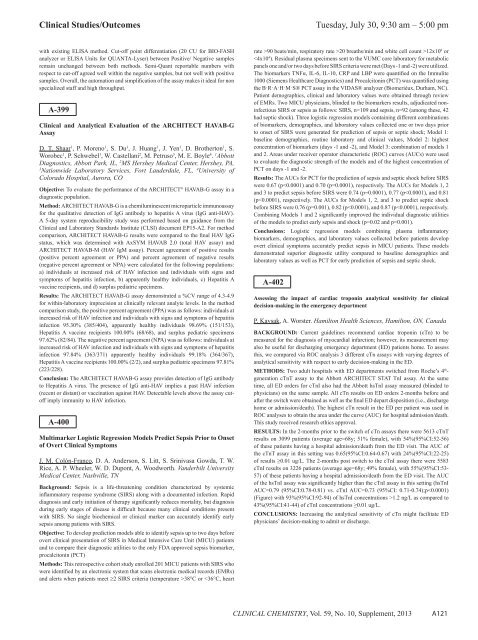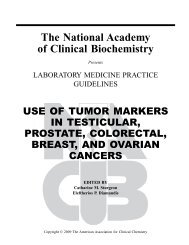Abstracts of the Scientific Posters, 2013 AACC Annual Meeting ...
Abstracts of the Scientific Posters, 2013 AACC Annual Meeting ...
Abstracts of the Scientific Posters, 2013 AACC Annual Meeting ...
You also want an ePaper? Increase the reach of your titles
YUMPU automatically turns print PDFs into web optimized ePapers that Google loves.
Clinical Studies/Outcomes<br />
Tuesday, July 30, 9:30 am – 5:00 pm<br />
with existing ELISA method. Cut-<strong>of</strong>f point differentiation (20 CU for BIO-FASH<br />
analyzer or ELISA Units for QUANTA-Lyser) between Positive/ Negative samples<br />
remain unchanged between both methods. Semi-Quant reportable numbers with<br />
respect to cut-<strong>of</strong>f agreed well within <strong>the</strong> negative samples, but not well with positive<br />
samples. Overall, <strong>the</strong> automation and simplification <strong>of</strong> <strong>the</strong> assay makes it ideal for non<br />
specialized staff and high throughput.<br />
A-399<br />
Clinical and Analytical Evaluation <strong>of</strong> <strong>the</strong> ARCHITECT HAVAB-G<br />
Assay<br />
D. T. Shaar 1 , P. Moreno 1 , S. Du 1 , J. Huang 1 , J. Yen 1 , D. Bro<strong>the</strong>rton 1 , S.<br />
Worobec 1 , P. Schwebel 1 , W. Castellani 2 , M. Petruso 3 , M. E. Boyle 4 . 1 Abbott<br />
Diagnostics, Abbott Park, IL, 2 MS Hershey Medical Center, Hershey, PA,<br />
3<br />
Nationwide Laboratory Services, Fort Lauderdale, FL, 4 University <strong>of</strong><br />
Colorado Hospital, Aurora, CO<br />
Objective: To evaluate <strong>the</strong> performance <strong>of</strong> <strong>the</strong> ARCHITECT ® HAVAB-G assay in a<br />
diagnostic population.<br />
Method: ARCHITECT HAVAB-G is a chemiluminescent microparticle immunoassay<br />
for <strong>the</strong> qualitative detection <strong>of</strong> IgG antibody to hepatitis A virus (IgG anti-HAV).<br />
A 5-day system reproducibility study was performed based on guidance from <strong>the</strong><br />
Clinical and Laboratory Standards Institute (CLSI) document EP15-A2. For method<br />
comparison, ARCHITECT HAVAB-G results were compared to <strong>the</strong> final HAV IgG<br />
status, which was determined with AxSYM HAVAB 2.0 (total HAV assay) and<br />
ARCHITECT HAVAB-M (HAV IgM assay). Percent agreement <strong>of</strong> positive results<br />
(positive percent agreement or PPA) and percent agreement <strong>of</strong> negative results<br />
(negative percent agreement or NPA) were calculated for <strong>the</strong> following populations:<br />
a) individuals at increased risk <strong>of</strong> HAV infection and individuals with signs and<br />
symptoms <strong>of</strong> hepatitis infection, b) apparently healthy individuals, c) Hepatitis A<br />
vaccine recipients, and d) surplus pediatric specimens.<br />
Results: The ARCHITECT HAVAB-G assay demonstrated a %CV range <strong>of</strong> 4.3-4.9<br />
for within-laboratory imprecision at clinically relevant analyte levels. In <strong>the</strong> method<br />
comparison study, <strong>the</strong> positive percent agreement (PPA) was as follows: individuals at<br />
increased risk <strong>of</strong> HAV infection and individuals with signs and symptoms <strong>of</strong> hepatitis<br />
infection 95.30% (385/404), apparently healthy individuals 98.69% (151/153),<br />
Hepatitis A vaccine recipients 100.00% (68/68), and surplus pediatric specimens<br />
97.62% (82/84). The negative percent agreement (NPA) was as follows: individuals at<br />
increased risk <strong>of</strong> HAV infection and individuals with signs and symptoms <strong>of</strong> hepatitis<br />
infection 97.84% (363/371) apparently healthy individuals 99.18% (364/367),<br />
Hepatitis A vaccine recipients 100.00% (2/2), and surplus pediatric specimens 97.81%<br />
(223/228).<br />
Conclusion: The ARCHITECT HAVAB-G assay provides detection <strong>of</strong> IgG antibody<br />
to Hepatitis A virus. The presence <strong>of</strong> IgG anti-HAV implies a past HAV infection<br />
(recent or distant) or vaccination against HAV. Detectable levels above <strong>the</strong> assay cut<strong>of</strong>f<br />
imply immunity to HAV infection.<br />
A-400<br />
Multimarker Logistic Regression Models Predict Sepsis Prior to Onset<br />
<strong>of</strong> Overt Clinical Symptoms<br />
J. M. Colón-Franco, D. A. Anderson, S. Litt, S. Srinivasa Gowda, T. W.<br />
Rice, A. P. Wheeler, W. D. Dupont, A. Woodworth. Vanderbilt University<br />
Medical Center, Nashville, TN<br />
Background: Sepsis is a life-threatening condition characterized by systemic<br />
inflammatory response syndrome (SIRS) along with a documented infection. Rapid<br />
diagnosis and early initiation <strong>of</strong> <strong>the</strong>rapy significantly reduces mortality, but diagnosis<br />
during early stages <strong>of</strong> disease is difficult because many clinical conditions present<br />
with SIRS. No single biochemical or clinical marker can accurately identify early<br />
sepsis among patients with SIRS.<br />
Objective: To develop prediction models able to identify sepsis up to two days before<br />
overt clinical presentation <strong>of</strong> SIRS in Medical Intensive Care Unit (MICU) patients<br />
and to compare <strong>the</strong>ir diagnostic utilities to <strong>the</strong> only FDA approved sepsis biomarker,<br />
procalcitonin (PCT)<br />
Methods: This retrospective cohort study enrolled 201 MICU patients with SIRS who<br />
were identified by an electronic system that scans electronic medical records (EMRs)<br />
and alerts when patients meet ≥2 SIRS criteria (temperature >38°C or 90 beats/min, respiratory rate >20 breaths/min and white cell count >12x10 9 or<br />
















